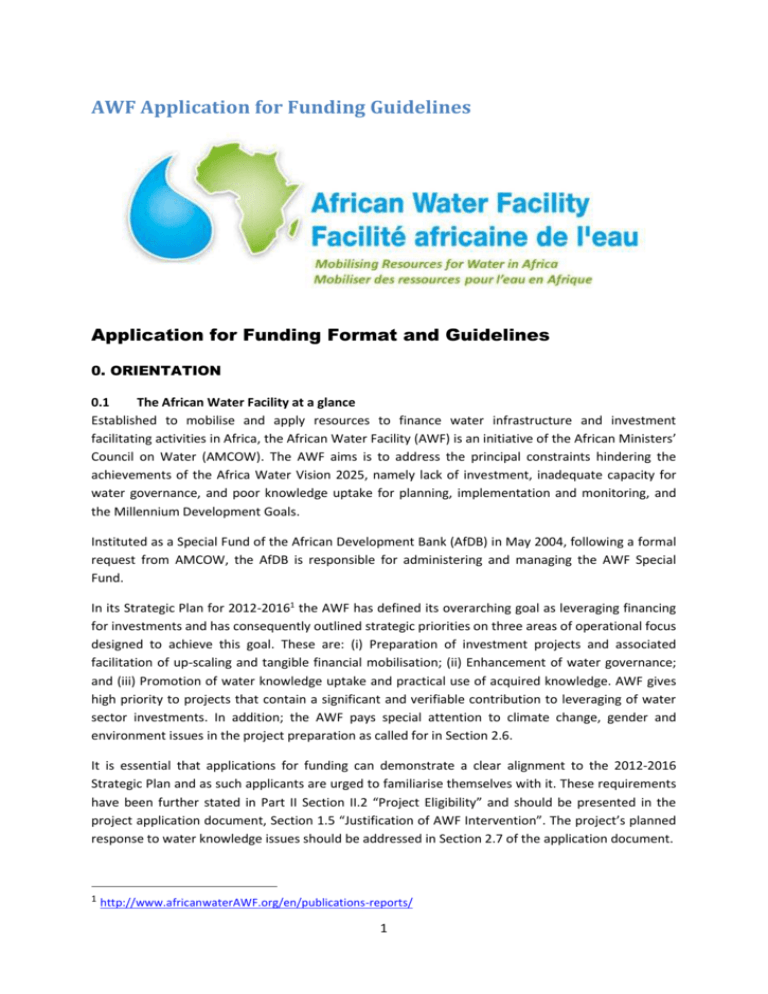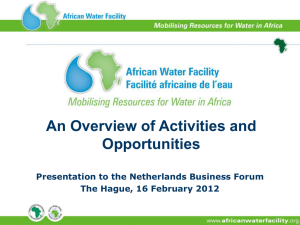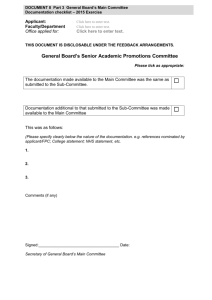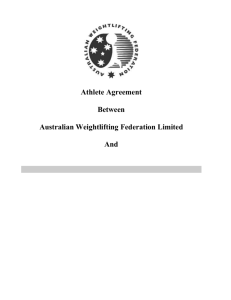Application Form - African Water Facility
advertisement

AWF Application for Funding Guidelines Application for Funding Format and Guidelines 0. ORIENTATION 0.1 The African Water Facility at a glance Established to mobilise and apply resources to finance water infrastructure and investment facilitating activities in Africa, the African Water Facility (AWF) is an initiative of the African Ministers’ Council on Water (AMCOW). The AWF aims is to address the principal constraints hindering the achievements of the Africa Water Vision 2025, namely lack of investment, inadequate capacity for water governance, and poor knowledge uptake for planning, implementation and monitoring, and the Millennium Development Goals. Instituted as a Special Fund of the African Development Bank (AfDB) in May 2004, following a formal request from AMCOW, the AfDB is responsible for administering and managing the AWF Special Fund. In its Strategic Plan for 2012-20161 the AWF has defined its overarching goal as leveraging financing for investments and has consequently outlined strategic priorities on three areas of operational focus designed to achieve this goal. These are: (i) Preparation of investment projects and associated facilitation of up-scaling and tangible financial mobilisation; (ii) Enhancement of water governance; and (iii) Promotion of water knowledge uptake and practical use of acquired knowledge. AWF gives high priority to projects that contain a significant and verifiable contribution to leveraging of water sector investments. In addition; the AWF pays special attention to climate change, gender and environment issues in the project preparation as called for in Section 2.6. It is essential that applications for funding can demonstrate a clear alignment to the 2012-2016 Strategic Plan and as such applicants are urged to familiarise themselves with it. These requirements have been further stated in Part II Section II.2 “Project Eligibility” and should be presented in the project application document, Section 1.5 “Justification of AWF Intervention”. The project’s planned response to water knowledge issues should be addressed in Section 2.7 of the application document. 1 http://www.africanwaterAWF.org/en/publications-reports/ 1 0.2 Application Guidelines The current guidelines offer all the information needed for applicants to prepare appropriate project proposals for funding by AWF later referred to as the “application”. The application will initially be reviewed by the AWF to decide if it qualifies for inclusion into the AWF project pipeline. Applications that have been entered into the pipeline will then be appraised by the AWF in consultation with the applicant. The AWF Project Appraisal Report will then serve as a basis for the approval for funding following the AWF-AfDB review and approval procedures. The guidelines comprise three parts: (i) Applicant Key Information, (ii) The Project Application Document including a step-by-step guide towards document completion, and; (iii) Eligibility Requirements for NGOs and CSOs. The application submitted to the AWF shall comprise: A covering letter; Applicant Key Information, the Project Application Document, and relevant supporting information (as required). It shall be submitted in electronic form to the AWF as indicated on the AWF website2. 0.3 Contact AWF Potential applicants are advised to contact the AWF at an early stage (at the above email address) for clarifications, briefly presenting the envisaged project before embarking on a full-fledged application. PART I: APPLICANT KEY INFORMATION I.1 Eligible Applicants The AWF’s eligibility requirements are stipulated in the AWF Operational Procedures published on its website (www.africanwaterfacility.org). Applicants eligible to receive AWF funding or other assistance directly from the resources of the AWF include: regional member countries of the AfDB, political subdivisions or agencies thereof as well as regional agencies or institutions concerned with water resources development in Africa. This implies that recipients can be bodies of the central or local government, a municipality, a non-governmental organisation (NGO) at the country or regional level, a civil society organisation, a community-based organisation (CBO); a regional, sub-regional and sectorial organisation (e.g. regional economic community (REC), a river basin organisation (RBO), and any other organisation whose credibility and role in the water sector could be verified and established. Specific eligibility criteria, rules and procedures will apply for AWF projects generated and implemented by NGOs/CSOs as further elaborated in Part III of these guidelines. Projects proposed by private sector, and adopted and owned by Regional Member Countries (RMCs) or RECs, would be eligible for Fund support, who would be the grant Recipient. In such situations, procurement would follow the AfDB’s rules and procedures such that the private promoter does not gain undue advantage. In exceptional circumstances projects generated and implemented by a private sector consulting company will be considered for funding provided that the project is clearly in the interest of the public good, that no revenue generation will accrue to the company, and that the RMC or REC endorses the project. 2 africanwaterfacility@afdb.org 2 I.2 Applicant Key Information Format 1) Name and address of applicant’s organisation State the name, postal address, telephone, fax and e-mail of the applicant organisation 2) Institutional and legal status of the applicant Provide information on the legal status of the Applicant (Proof of Legal Establishment/Registration, Main Function and Activities, or equivalent). The legal instrument (or other authorisations) granting the applicant the authority to mobilise and manage resources for the project should be mentioned. 3) Organisation and management Provide information on (i) the structure of the organisation, the staffing, the management team, (ii) financial management and financial governance as well as capacity to handle the proposed external funding, and (iii) financial reporting and auditing 4) Names and addresses of co-financiers and partners (When Applicable) State names and postal addresses of the co-financiers and partners NB. It is assumed that the final recipient of the grant is the executing agency on its own behalf or on behalf of clearly identified eligible beneficiaries. If the recipient is different from the executing agency, the relationship between the two should be clearly shown and the capacities to undertake the respective responsibilities should be demonstrated PART II – THE PROJECT APPLICATION DOCUMENT II.1 Introduction This section lists the project information needed for its appraisal by AWF including assessment of its relevance and alignment with the AWF’s strategic priorities, its readiness for funding, the applicant’s capacity and other determinant factors for the project appraisal and associated decision making. The project application document should adopt the table of contents indicated in section I.3. II.2 Project Eligibility The eligibility of projects for funding under the AWF depends on the relevance of their focal thematic areas and approaches in the context of AWF’s strategic priorities. In order to more effectively address the emerging water sector challenges facing the African continent, the AWF has sharpened its operational focus on some high impact areas of intervention. As stated in the AWF Strategic Plan 2012-2016 the objective for the period is to leverage investments under the following three strategic priorities: (i) Preparation of investment projects and associated facilitation of up-scaling and tangible financial mobilisation; (ii) Enhancement of water governance; and (iii) Promotion of water knowledge uptake and practical use of acquired knowledge. The eligibility of a proposed project will be established on the basis of its demonstrated compliance with, and effective response to, the three focal areas. 3 II.3 Project Application Document Format The document should be clear, concise and not exceed 15 pages excluding leading pages and annexes. General information of marginal relevance for the application should be kept to a minimum. The application document shall comprise the following elements and number of pages: List of Acronyms and Abbreviations Table of Contents, Lists of Tables and Annexes RESULTS-BASED LOGICAL FRAMEWORK (see format in Annex A) EXECUTIVE SUMMARY (max 1 page) 1 1.1 1.2 1.3 1.4 1.5 BACKGROUND Project Rationale and Origin Sector Status and Priorities Problem Definition Beneficiaries and Stakeholders Justification of AWF Intervention (max 2 pages) 2. 2.1 2.2 2.3 2.4 2.5 2.6 2.7 2.8 THE PROJECT (max 8 pages of which 4 for Components and Activities) Goal and Impact Outcomes Outputs Activities Risks and Assumptions Climate change, environmental protection, gender and social equity aspects Water Knowledge Issues Cost and Financing 3 3.1 3.2 3.3 3.4 3.5 3.6 3.7 PROJECT IMPLEMENTATION (max 4 pages) Recipient and Executing Agency Implementation Arrangements Implementation Schedule Procurement Arrangements Disbursement Arrangements and Schedule Financial Management Arrangements Monitoring and Reporting Arrangements ANNEXES Map Cost Estimate Implementation Schedule Other as required 4 II.4 Guide for Completing the Project Application Document The project application document is the applicant’s document and its contents will be tailored to the nature, objectives, and size of the project. In this respect, the descriptions below are not all-inclusive but just meant to provide some guidance for the preparation of the application document. EXECUTIVE SUMMARY Prepare a concise summary of the basic elements and qualities of the proposed project to highlight the main qualities of the project and enable any reader to “visualise” it better. RESULTS-BASED LOGICAL FRAMEWORK The applicable format of the AWF Results-Based Logical Framework of the project is shown in Annex A. The Logical Framework will serve as a key instrument for defining the expected chain of results of the project emerging from its activities and finally resulting in desired impacts. It shall provide a set of key measurable performance indicators, with time phased targets, as basis for performance monitoring and reporting (Section 3.7). The Logical Framework shall also summarise the risks facing the project and planned measures to mitigate those risks. 1 BACKGROUND 1.1 Project Rationale and Origin Provide a historical background of the project, explaining with clarity how it came about and what triggered it and links to similar projects if relevant. The core problem(s) which the project attempts to address should be clearly stated and defined, as well as the involvement of stakeholders and beneficiaries in project definition and preparation. Whenever possible, state alternative courses of action considered and how the present option was selected. The statement of the project rationale should be underpinned by explanation of the main source(s) of demand for project interventions to address identified problems. In particular, demand from population groups, including marginalised people who seek to address problems identified by such populations will need to be demonstrated. Special kinds of demand to be highlighted should be those from: (i) Needs for financial mobilisation for up-scaled infrastructure investments, (ii) Knowledge and information demands, (iii) Improved governance requirements including institutional capacity building, and other forms of technical assistance. 1.2 Sector Status and Priorities State the wider governance and strategic context of the challenges to be addressed by the project (e.g. national, sub-regional, regional or basin-wide context), including national water policies, water resources management, development strategies, and on-going programmes related to the focal themes of the project. Explain how the project falls within the national, sectorial or local government policies and strategic plans and whether the project is already included in national, sectorial, or local development programmes. For a central government agency applicant, elaborate on the progress in the development of plans for IWRM, water supply and sanitation, water and food security, water related economic sectors, etc. Also assess the political commitment of the national government and local government with respect to appropriate prioritisation of water sector, such as inclusion of water as a priority with the national and local development policies, and Poverty Reduction Strategy 5 Paper (PRSP). Also demonstrate how the proposed project will contribute to the upgrading of the water related sectors under the national development policy and MDG achievement strategies. 1.3 Problem Definition State precisely the key problems/challenges that the project seeks to solve and elaborate on the causes of the problem. Also present opportunities and approaches for addressing the challenges including reference to relevant self-help measures being taken by the recipient that the project will make use of to contribute to improvements. Also address other opportunities such as policy reforms, project related investments, on-going or completed design studies, state of progress of associated projects, and project endorsement by national, sector or local government authority. 1.4 Beneficiaries and Stakeholders Identify the direct and indirect beneficiaries and other key stakeholder groups and anticipated number. Show how their interests and concerns have been incorporated into the project. Clearly state if the project is expected to have specific positive impact on women, girls, marginalised people, or other vulnerable citizens. Show if there are possible areas of conflict and how they will be addressed. Provide evidence that the project is community demand driven and the nature of demand, involvement, and capacity of the targeted community, institutions, stakeholders or beneficiaries. Also explain how the latter are showing a sense of ownership and commitment through active participation in the project preparation and indicate how beneficiaries will undertake operation and maintenance in a sustainable manner, or how they have done so in the past. 1.5 Justification of AWF Intervention This is an essential issue of the application aimed at verifying that the project is closely aligned with the priorities of the AWF Strategic Plan 2012-163. The applicant has to take this strategy into consideration to ensure that the proposed project will duly respond to the three focal priorities of the AWF (presented in part II.2 of these guidelines). Also provide evidence that the proposed project has been prepared as a participatory exercise involving beneficiaries and stakeholders and explain how the project interventions will contribute to the attainment of AWF strategic priorities. 2 THE PROJECT Ensure that the project description in this chapter is consistent with the Results-Based Logical Framework (II.4 and Annex A). 2.1 Goal and Impacts This section should provide more details to the high level development goal and impact that the project will contribute to. The impact or “long term changes” attributable to the project are changes expected to come about as a result of this project and other related projects. The impacts defined in this section and summarised in the Results-Based Logical Framework should present clear goals and impacts and associated indicators for assessing the achievements. Typical impacts of a project include improved health and sanitary conditions of communities, improved water related livelihoods, 3 http://www.africanwaterfacility.org/en/publications-reports/ 6 gains to agriculture from improved land and water management, and reduced risk of floods and droughts, to name a few. Describe the situation “with” and “without” project scenarios. . 2.2 Outcomes In this section, applicants are required to describe (in narrative format), various outcomes directly attributable to the project. The outcomes are the consequences of actions taken to meet certain purposes resulting from the project outputs stated in section 2.3. The outcomes descriptions should demonstrate how they relate to the AWF strategic priorities in terms of: (i) Up-scaling and investment projects that should be prepared and funding that will be mobilised that that can be attributed to the project; (ii) Concrete outcomes regarding improved water governance capacity and performance for effective and sustainable investments; and (iii) New knowledge that will support achievement of tangible improvements for beneficiaries within and beyond the project (also see section 2.7). A project may have a combined focus on these three priority areas to benefit from synergies. A table could be used to summarise the outcomes. 2.3. Outputs State the expected Outputs in terms of immediate products or deliverables of the activities under each component described in 2.4. Outputs are generally characterised, for instance, by improved performance of an institution, new infrastructure, reports and deliverables leading to changes. Be specific and describe qualitative and quantitative outputs that the activities will produce. 2.4 Activities Applicants are required to define the various activities needed to accomplish the abovementioned outputs, outcomes and impacts of the project. The activities should be organised under project components including reference numbers for easy identification. One of the components should be dedicated to project implementation management, coordination, performance monitoring, and project completion. All activities shall be clearly identified including their links to the chain of impacts in the Results-Based LFA matrix and the applicants are expected to: (i) Include the title and a detailed description of each activity to be undertaken to produce the results; (ii) Specify the role of each implementing partner; (iii) Outline the involvement of stakeholders and beneficiaries in the activities; (iv) Discuss for each activity the risk that may prevent it from being carried out as planned and the mitigation measures foreseen (harmonise with section 2.5). The list of activities should encompass all major actions that have budget and human resources implications and further dealt with in the cost estimates to ensure that all activities have been adequately budgeted for. 2.5 Risks and Assumptions Identify the potential threats and risks and show how these will be mitigated and addressed by the project. The application shall take into consideration a broad range of risk categories, for example: (i) Weak political support and ownership at national and local government level; (ii) Inadequate capacity of the recipient/executing agency to implement the project effectively; (iii) Poor local response in community driven projects, (iv) Risk of inappropriate technological solutions or cost overruns; (v) Limited donor and investor interest to finance up-scaling efforts and invest in identified bankable projects; (vi) Risks due to climate change and variations such as abnormal hydrological regimes, water insecurity, and erosion problems; (vii) Environmental risks; and (ix) Risks related to project sustainability (post-project management, cost recovery, and operation & maintenance). The risk 7 assessment should be fact-based and be done to enable project designers to assess key variables that influence project performance and impacts. It shall address the likelihood of each threat, its significance for the project, and how the project will mitigate each risk. 2.6 Climate change, environmental protection, gender and social equity aspects Committed to promoting the sustainable development of the water sector, the AWF ensures that climate change, environmental protection, gender and social equity issues are properly addressed throughout its portfolio. To that effect, AWF will highly regard project proposals that effectively take into account one or several of these issues. Gender and Social Equity Present the project related gender and social equity issues (also indicating the positive impacts and benefits) in short, medium and long term perspective. Guiding questions: Does the project design include specific benefits and gains for women/girls/poor/young people/vulnerable communities and or the disabled? How so? Are provisions made to include women/girls/poor/young people/vulnerable communities and or the disabled participation? How so? How and how many women/girls/poor/young people/vulnerable communities and or the disabled are involved in this project? (among other questions) Etc. Climate Change Elaborate on the project’s response to climate change adaptation and mitigation challenges. Guiding questions: Is the project promoting the use of renewable energy (wind, solar, etc.) for power generation? How so? Is the project designed with the current or predicted impacts of climate change on the water resources on which the project depends in mind? How so? How is the project planning to adapt to those potential impacts on the water resources for the sake of the long term sustainability of the project? Environmental and Social Impacts Explain how issues of environmental and social impact have been, and will be, addressed by the project. Present environmental and social impacts assessments to be carried out as part of the project underpinned by applicable safeguarding requirements (such as involuntary resettlement) depending on the nature of the project4. 4 (AfDB ESA/SIA) (http://www.afdb.org/en/documents/environmental-social-assessments/environmental-and- social-impact-assessments-esias/ 8 Guiding questions: What is the considered environmental category of the project? Are there plans to avoid, reduce or mitigate the adverse impacts of the project on the environment/biodiversity/communities? If applicable, have communities affected by the project been consulted or will they be? How? Does the project include provisions for protecting biodiversity and preventing land degradation? 2.7 Water Knowledge and Communication Issues Each AWF funded project is expected to add tangible value to existing water knowledge that will be further synthesised by the AWF and effectively shared with a wider audience during and after the project. It is important that the recipients and executing agencies are aware of, and respond to, the knowledge dimension of each project. In this respect, the application should include an outline knowledge and communication plan5 that will be vital in facilitating the exchange of information and knowledge on project outputs, planned and unintended outputs and outcomes, as well as possible stories arising from the project. The latter could preferably be supported by photos, and video interviews in the field. This section should state the type of knowledge or innovation that is expected to emerge from it and indicate the processes designed to capture knowledge during the project’s implementation. It should also suggest the process and provisions to disseminate this knowledge and use it to support actions that will help beneficiaries and water development and management actors and at local, national, and regional level. As a clue the AWF’s water knowledge involvement comprises the following areas: (i) Support to national, regional and trans-boundary water information systems; (ii) Support towards establishing monitoring and evaluation systems at national, sub-regional and continental levels; (iii) Strategic foresight analysis of the state of water and development trends; (iv) Studies on institutional arrangements, financing mechanisms, technologies, etc., that enhance the development of sustainable water infrastructure. 2.8 Cost and Financing The applicant shall provide in annex a cost estimate for the project, amount requested from the AWF and other expected sources of funding. The cost estimate (in Euro) shall be clearly linked to proposed project activities in detail that will allow the AWF to make a cost estimate assessment. Annex B gives an indicative template for the cost estimate, which will have to be accustomed to the nature of each particular project. The personnel costs shall be based on a matrix showing estimated workload (number of staff-months6) for each staff/consultant under each identified activity. This will be multiplied by the monthly fee of each team member to establish the estimated personnel costs. State the origin and basis of the applied unit costs and whether the costs are exclusive or inclusive of Government taxes and duties noting that AWF funds shall not be used to pay any Government taxes and duties. 5 Successful applicants will also be expected to follow AWF Communication and Visibility Guidelines 2012, which will be communicated at the time of contract 6 A measure for working time input - using 22 staff-days in one staff-month 9 This section shall also indicate the sources of funding for each activity/component distributed between the AWF and the Recipient, and other contributors as applicable. The AWF expects that the Applicant will contribute to the funding of the project, either in cash or in-kind. Also state if parts of the project are already financed from other sources such as matching funding of existing projects that will be influenced by, or being part of, the proposed project. Example of Summary Table for Cost Estimate by Component and Source of Funding7 Total Cost Component A: [name] Sub-Total A Component B: [name] Sub-Total B Component C: [name] Sub-total C TOTAL Price Contingency Currency Exchange Contingency GRAND TOTAL Contributions (EUR) Percent contribution (%) 1 AWF Contribution Recipient and other Contributions 1 Rate Add a column per contributor 3. PROJECT IMPLEMENTATION 3.1 Recipient and Executing Agency Provide key information about the Applicant who will later become the Recipient e.g. the signatory of the AWF Grant Agreement subject to project approval. The proposed project application shall also give information about the proposed Executing Agency with overall responsibility for project implementation. The required information should comprise: (i) Legal status, (ii) Organisational structure; (iii) Human resource capacity and experience; and (iv) Assets and facilities (office, buildings, equipment, supplies, and transportation). 3.2 Implementation Arrangements The methodology for implementing actions is a crucial component of the project design. This section shall present the proposed approaches and arrangements for the implementation of the project. It shall present the roles, responsibilities, organisational set-up, and key staff (positions) assigned to work on the project implementation including the day-to-day administration and financial management and reporting of the project. This should be supported by a simple organisational chart showing the overseeing function (Steering Committee, etc.), executing agency, implementing partners, consultants, stakeholders, donors and local authorities directly engaged in project 7 Indicative template for more detailed estimate presented in Annex B 10 implementation. Explain the governing, administrative and operational functions and lines of responsibility and accountability of the various actors. This section should also explain how the project intends to build on previous and current projects (where applicable) and to which degree the project is shared with, and backed by, the stakeholders and their commitment to project implementation and subsequent operations. Moreover, it should outline and justify the role of private sector (where applicable) and how the implementation process will enable and enhance private sector participation. 3.3 Implementation Schedule Provide an implementation schedule showing the timelines for each component and associated activities broken down into tasks and showing key milestones and deadlines. The implementation schedule should not present real dates, but simply show "month 1", "month 2", “month 3”, as activity periods. It is recommended to allow some flexibility in the timetable to accommodate unforeseen delays. It is important that the timetable allows sufficient time for project implementation preparation and procurement processes. The action plan should use component and activity titles as they appear in Section 2.4. 3.4 Procurement Arrangements Prepare tentative procurement arrangements including: (i) List of works, goods and services to be procured under the project and the related cost estimates. The procurement details and modalities will be addressed by the AWF during the appraisal of the project. 3.5 Disbursement Arrangements and Expenditure Schedule This part will be addressed by the AWF as part of the appraisal process. 3.6 Financial Management Present the recipient’s financial management and fiduciary control arrangements for the project as a basis for the AfDB’s assessment during project appraisal. 3.7 Monitoring and Reporting Arrangements The Results-Based Logical Framework Approach (LFA) (Annex A) of the project will serve as a key instrument for monitoring the performance and results of the projects in terms of impacts, outcomes and outputs of the project activities. The Applicant should present an outline Project Performance and Implementation Plan with reference to the LFA how data will be collected (including beneficiaries involvement), and planned progress reporting. The Plan should also include a table summarising major documents to be produced and associated deadlines and review arrangements. ANNEXES Maps: Country/Location and Project Area; Methodology descriptions; Detailed project activities; Time schedule with important milestones; Terms of Reference (in case the project will involve studies and technical assistance support carried out by consultants); 11 Details of staff inputs and project cost estimates. 12 PART III: ELIGIBILITY REQUIREMENTS FOR NGOs AND CSOs A. Official Recognition NGOs and Civil Society Organisations (CSOs) will need to fulfil the following criteria establishing their credibility and track record in the water sector. Provide information about such organisation given that it should: i) ii) iii) iv) v) vi) vii) viii) Be a non-governmental organisation committed to the continent’s or national development priorities and that the proposed activities will be implemented in Africa; Be Africa-based or provide evidence of partnership with African institutions; Provide evidence of current valid legal registration under the laws of the Regional Member Country of AfDB (RMC) in which it is operating, as well as evidence of a certificate to carry out business in the RMC, in which it intends to carry out the relevant activity, if different from the place of legal registration; Have appropriate organisational and management capacity, including a governing board; Show the existence of a sound financial system - including clear accounting and budgeting standards, financial statements, a transparent budgeting process, audited accounts and other indicators that confirm their capacity to assume fiduciary responsibility for AWF resources; Provide evidence of competence, based on past performance, to carry out proposed activities; Demonstrate credibility, knowledge of local values, networks and structures required to carry out the indicated activities; Have the proposal supported by the national government as evidenced by a letter signed by the appropriate official of the government, at the Ministerial level, indicating that the country supports the request as being consistent with national priorities. This letter must be sent together with the application for support. B. Eligible Project Implementation Management Expenditures Special eligibility requirements will apply if both the applicant and the Executive Agency are NGOs. The remuneration of the NGO’s basic staff salary expenditures would not be eligible for AWF funding (such expenditures should be considered as part of the Recipient’s funding/in-kind contribution). If the project implementation management function is sub-contracted by the applicant to an external institution or consultant, the financing of associated PIU fees and expenses would in principle be eligible for AWF financing following the rationale that such expenditures may be directly projectrelated since they are necessary for the achievement of project objectives, subject to: I. II. III. A valid justification for the establishment of a specific PIU and the productive nature of the expenditure; The existence of an acceptable performance contract between the PIU and the Recipient NGO; and A competitive recruitment process for the PIU. Project related goods (e.g. vehicles, equipment, instruments, etc.) are assets that after project completion in principle will be handed over to the institution responsible for the long term sustainability of the project interventions. 13 Annex A: RESULTS-BASED LOGICAL FRAMEWORK Country and Project Name: Purpose of the project: PERFORMANCE INDICATORS Indicator (including CSI) Baseline Target KEY ACTIVITIES OUTPU TS OUTCOMES IMPACT RESULTS CHAIN MEANS OF VERIFICATION INPUTS Component 1 : Component 2 : Component 3 : Component 1 Component 2 Component 3 14 RISKS / MITIGATION MEASURES ANNEX B: INDICATIVE TEMPLATE FOR PROJECT COST ESTIMATES B.1: STAFF AND CONSULTANTS COST ESTIMATE Item Staff/Consultant8: Component A (Title) Activity A.1 (staff-months) Activity A.2 (staff-months) Activity A.3 (staff-months) Sum A (Staff-moths Unit Rate (EUR/s-m) Sub-total A (EUR) Staff (S1) (S2) Total (S3) (S4) Component B (Title) Activity B.1 (staff-months) Activity B.2 (staff-months) Activity B.3 (staff-months) Sum B (Staff-months) Unit Rate (EUR/s-m) Sub-total B (EUR) Component C (Title) Activity C.1 (staff-months) Activity C.2 (staff-months) Activity C.3 (staff-months) Sum C (Staff-months) Unit Rate (EUR/s-m) Sub-total C (EUR) Total Staff Cost (EUR) 8 Show staff position, such as Team Leader, Water Engineer, Economist etc. for all staff involved in project 15 B.2: OVERALL PROJECT COST ESTIMATE – INDICATIVE TEMPLATE Description Unit Quantity Unit Rate (EUR) Total (EUR) AWF Contribution (EUR) Contribution from Recipient and other9 (EUR) Component A a) Services 1) Staff/Consultant10: 2) Services11: 3) Operational Expenditure12 Sub-total a) Services (EUR) b) Goods13: Sub-total b) Goods (EUR) c) Works14: Sub-total c) Works (EUR) Total Cost Component A Total Cost Component B15 Total Cost Component C16 Total Cost Estimate 9 Add a column per contributor From Staff cost table above; Clearly differentiate costs of Executing Agency staff and external consultants) 11 Such as surveys, w/shops, travel international and national, allowances 12 office expenses, telecommunication 13 Such as purchasing of vehicles, IT equipment 14 Such as water infrastructure investments for demonstration purposes, pilot plants for innovation and upscaling, etc. Cost estimates should be made based on preliminary studies when available or standard ratios (e.g. cost per borehole or per ha irrigated). 15 Same as for Component A 16 Same as for Component A 10 16 NB: project management costs if any should be gathered in the same component. A clear justification of estimates should be included as footnotes to this table if necessary. 17





